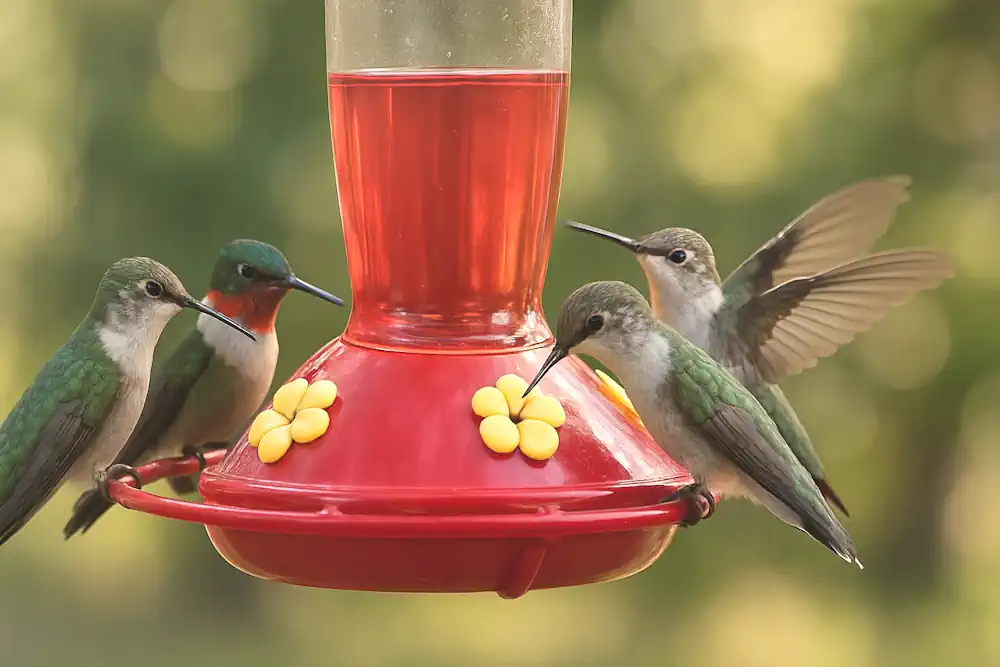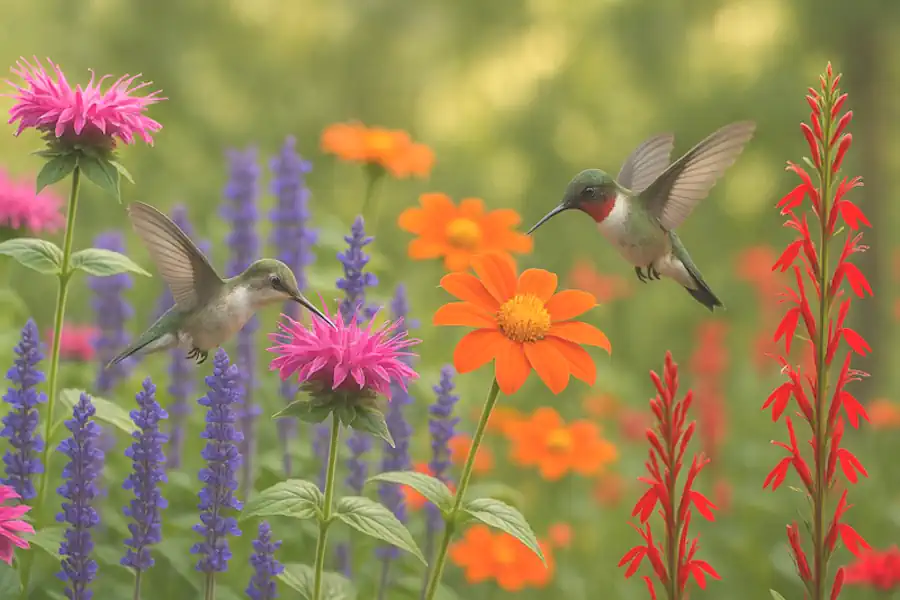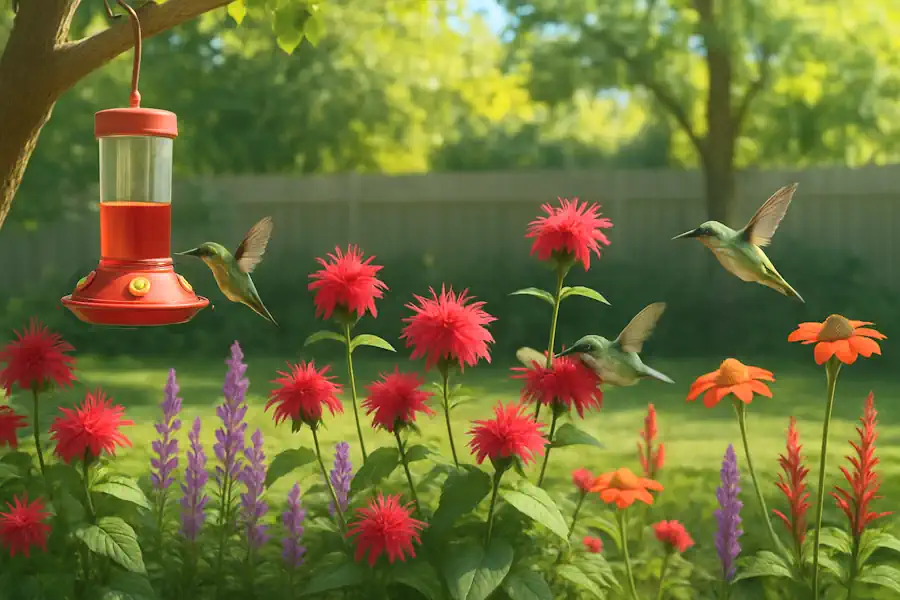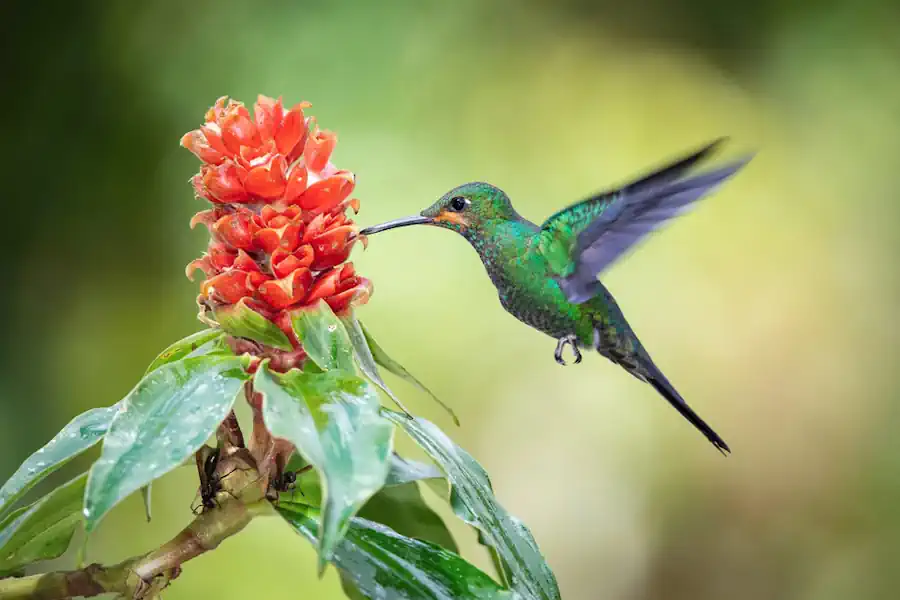Those charming little hummingbirds darting around your yard deserve better than the sugar water most of us offer them. I’ve watched countless neighbors—myself included—hang those bright red feeders with the best intentions, completely unaware that we’re essentially serving these magnificent creatures the equivalent of fast food.

Store-bought nectar lacks up to 30 essential micronutrients these tiny powerhouses need for their incredible metabolisms that allow them to beat their wings 50-80 times per second.
The truth? We’ve been getting it wrong for years. While those feeders might attract hummingbirds to your yard, they’re not providing the complete nutritional profile these birds evolved to consume. Real flower nectar—the stuff nature designed—contains critical amino acids, antioxidants, and trace minerals that support everything from feather development to migration stamina. And let’s be honest, wouldn’t you rather see these jewel-toned visitors sipping from gorgeous blooms than plastic containers anyway?
The Sugar Water Shortfall
I still remember the day I proudly hung my first hummingbird feeder. Red liquid, check. Perfect spot on the porch, check. Feeling like Mother Nature herself, check. Nobody told me I was basically offering these incredible birds the equivalent of soda pop.
Here’s the problem: that store-bought nectar (or homemade sugar water) is basically just empty calories. It’s like trying to live on nothing but candy—you’d survive for a while, but you’d be missing crucial nutrients.
The typical 4:1 water-to-sugar ratio provides energy, sure. But energy alone isn’t enough.
Real flower nectar contains protein-building amino acids, metabolism-supporting minerals, and protective antioxidants. These nutrients help hummingbirds maintain their astonishing energy output and support their overall health during breeding and migration seasons.
Think about it this way—would you perform at your best if you ate nothing but sugar?
Nature’s Perfect Hummingbird Buffet
So what’s the alternative? (I’m glad you asked!)
The answer is literally blooming all around us. Native flowering plants offer exactly what these birds need—complete nutrition packaged in beautiful, sustainable delivery systems.
Last spring, I helped transform a corner of my friend’s yard into a hummingbird haven, and the results were nothing short of magical. Within weeks, she had regular visitors who stayed longer and displayed more natural behaviors than when she relied solely on feeders.
Some standout performers in her garden included:
- Bee balm (Monarda) – Their wild, spiky red blooms are like hummingbird magnets
- Salvia – The tubular flowers perfectly match hummingbird bills
- Mexican sunflower (Tithonia) – Bright orange blooms that flower prolifically
- Cardinal flower (Lobelia cardinalis) – A native that produces nectar-rich red flowers
The difference was striking. Instead of quick pit stops at the feeder, the birds spent time exploring, perching, and even defending their favorite plants. They weren’t just eating—they were engaging with their environment the way nature intended.

You Don’t Have to Choose—Supplement Instead
[Important] You don’t need to toss your feeders immediately! They can still serve as supplemental food sources, especially during early spring or late fall when natural nectar might be scarce.
My neighbor Elaine—a retired biology teacher and certified hummingbird enthusiast—taught me this balanced approach. “Feeders can help attract hummingbirds initially,” she told me over coffee one morning, “but the plants will keep them coming back and provide what they really need.”
“Hummingbirds evolved alongside flowering plants for millions of years. Their nutritional needs are perfectly matched to what these plants provide. Our sugar water is a poor substitute for this ancient relationship.”
I’ve found that placing feeders near native plantings creates a perfect scenario—the birds discover the feeders and then explore the surrounding plants. Win-win!
Getting Started: Your First Hummingbird Garden
Ready to give it a try? You don’t need a massive yard or a green thumb.
Even a few containers on a balcony can make a difference. The key is choosing the right plants and creating a succession of blooms that provides nectar throughout the season.
Start small. That’s what I did.
My first attempt was just three containers of different salvias on my balcony. The joy of seeing my first visitor—a ruby-throated hummingbird that I named Rocket—was worth every penny spent on those plants.
When selecting plants, consider these factors:
- Bloom time (aim for continuous flowering from spring through fall)
- Flower shape (tubular flowers are hummingbird favorites)
- Color (reds and oranges are particularly attractive)
- Native status (local native plants often provide the best nutrition)
Plant in clusters rather than single specimens—this creates more visual impact to attract birds and provides a more substantial food source.

The Bigger Picture: Why This Matters
This isn’t just about having pretty birds visit your yard (though that’s a fantastic perk). It’s about something much bigger.
Hummingbirds are pollinators. As they move from flower to flower, they transfer pollen, helping plants reproduce. In our increasingly fragmented natural landscapes, every backyard habitat helps create corridors for these important ecological partners.
And let’s be real—we’ve taken so much natural habitat away from wildlife. Creating these small pockets of native plants is one small way to give something back.
I’ve seen the difference in my own neighborhood. What started as my small garden has inspired at least three neighbors to plant for hummingbirds, too. That’s how change happens—one yard, one balcony, one container at a time.
Beyond Feeding: Creating a Complete Habitat
While we’re on the subject, let’s talk about the whole package. Hummingbirds need more than just food—they need places to rest, materials to build nests, and safety from predators.
Consider adding:
- Small trees or shrubs for perching and nesting
- A water feature with a mister or bubbler (hummingbirds love to bathe!)
- Native plants that support insects (hummingbirds feed insects to their young)
And please—I’m begging you—skip the pesticides. Those bugs aren’t just garden pests; they’re an essential protein source for hummingbirds and their babies.
My friend Matt learned this lesson the hard way. After spraying his roses, he noticed his regular hummingbird visitors disappeared for weeks. “I never made that mistake again,” he told me. “Now I accept a few holes in my leaves as the price of having these amazing birds around.”
The Joy Factor: Why We Do This
There’s something almost magical about having a tiny, iridescent bird hover inches from your face. I can’t count the number of mornings I’ve sat with my coffee, watching “my” hummingbirds go about their busy lives.
It changes you.
In our hyper-digital world, these connections to nature ground us in something real and vital. They remind us that we’re part of something bigger—an intricate web of relationships that sustains all life.
And honestly? They’re just ridiculously fun to watch. Their aerial acrobatics, territorial displays, and surprising personalities provide endless entertainment. My resident male ruby-throat dive-bombs any squirrel that dares approach his favorite salvia patch. It’s better than television, I swear.
So yes, creating a proper hummingbird habitat takes more effort than hanging a feeder. But the rewards—for both the birds and for us—are immeasurably greater.
Your Next Steps
As I write this in early spring 2025, it’s the perfect time to start planning your hummingbird garden. These tiny travelers will be returning from their winter grounds soon, hungry and looking for welcoming habitats.

Start by researching which hummingbird species visit your region and when they typically arrive. Then select a few native plants that will bloom around that time. Your local native plant society or extension office can provide specific recommendations for your area.
Remember, you don’t have to go all-in immediately. Even adding one or two hummingbird-friendly plants near your existing feeder is a step in the right direction. Nature appreciates our efforts, however small.
And when you see your first hummingbird hovering among the flowers you planted? Well, that feeling is simply impossible to describe. You’ll just have to experience it for yourself.
Let’s give back to nature in the most beautiful way possible—one flower, one garden, one hummingbird at a time.
